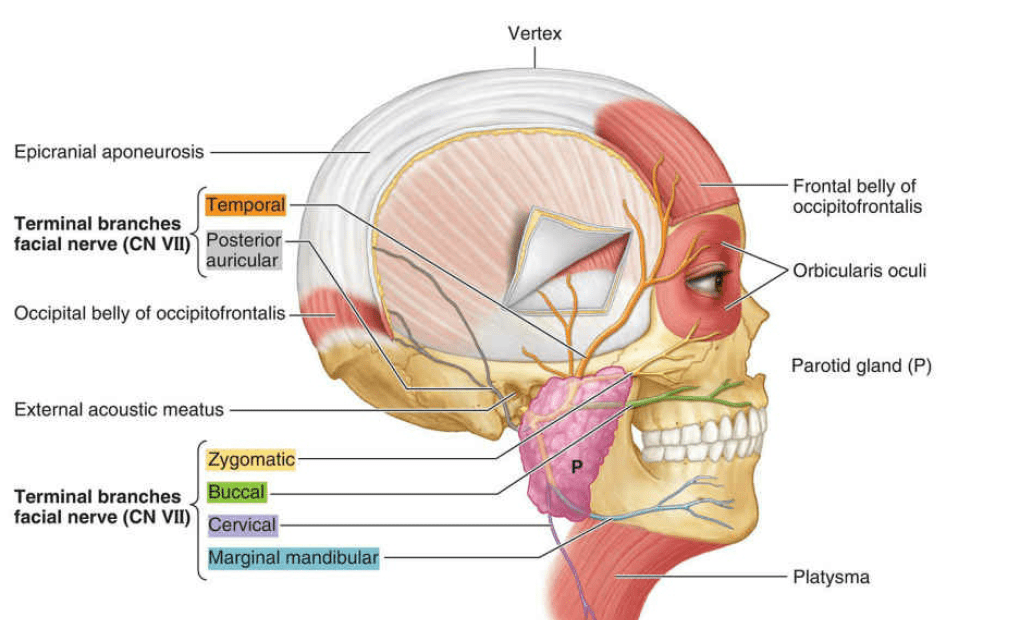Parotid Disease
content of this page
1- Introduction
2- Anatomical Overview
3- Causes
4- Treatment
Introduction
Parotid disease affects the parotid glands, which are the largest salivary glands located in front of the ears. Conditions include infections, inflammation, and tumors. Symptoms often involve swelling, pain, and dry mouth. Diagnosis may require physical exams and imaging, while treatment depends on the specific condition and its severity.

Anatomical Overview
The parotid glands are the largest of the salivary glands, located on each side of the face just in front of the ears. They are responsible for producing saliva, which aids in digestion and helps keep the mouth moist. Each parotid gland has a duct, called Stensen’s duct, which opens into the mouth near the upper second molar, allowing saliva to flow into the oral cavity. These glands are composed of two lobes, the superficial and deep lobes, separated by the facial nerve, which is critical for facial movements. The anatomical position of the parotid glands makes them susceptible to various conditions such as infections, inflammation, and tumors, which can impact their function and cause symptoms like swelling, pain, and dry mouth.

Causes
Infections: Bacterial infections, such as those caused by Staphylococcus aureus, or viral infections, such as mumps, can lead to inflammation of the parotid glands (parotitis).
Blockages: Blockages in the parotid duct, often caused by salivary stones (sialolithiasis), can obstruct saliva flow, leading to gland swelling and infection.
Autoimmune Disorders: Conditions like Sjögren’s syndrome, where the body’s immune system attacks its own salivary glands, can cause chronic inflammation and reduced saliva production.
Tumors: Both benign (e.g., pleomorphic adenomas) and malignant (e.g., mucoepidermoid carcinoma) tumors can develop in the parotid glands. These tumors can cause noticeable swelling and, in some cases, pain.
Injury: Trauma to the face can damage the parotid glands or their ducts, leading to inflammation or infection.
Chronic Conditions: Chronic illnesses, such as diabetes, can predispose individuals to parotid gland issues due to changes in saliva production and gland function.
Dehydration and Poor Oral Hygiene: Lack of adequate hydration and poor oral hygiene can increase the risk of bacterial infections in the salivary glands.
Treatment
Addressing the Underlying Cause:
- Medical Treatment: If agnosia is due to a condition like stroke, infection, or tumor, appropriate medical treatments are necessary. This might include medications to manage stroke risk factors, antibiotics or antiviral drugs for infections, and surgery or chemotherapy for tumors.
- Rehabilitation for Brain Injury: Patients with agnosia resulting from traumatic brain injury may benefit from a comprehensive rehabilitation program that addresses cognitive and physical deficits.
Occupational Therapy:
- Occupational therapists help patients develop strategies to compensate for their sensory deficits. This might include using other senses to identify objects, organizing environments to reduce confusion, and practicing daily tasks in a structured manner.
Speech and Language Therapy:
- Speech-language pathologists can work with patients who have difficulty with language-related agnosias, such as pure word deafness. Therapy might focus on improving communication skills and developing alternative strategies for understanding spoken language.
Visual and Auditory Training:
- For visual agnosia, patients may engage in exercises that enhance their ability to recognize and interpret visual stimuli. This might include practicing with different types of objects, faces, and scenes.
- For auditory agnosia, training might involve exercises to improve sound recognition and differentiation, using both verbal and non-verbal sounds.
Adaptive Techniques:
- Using labels, notes, or electronic devices to help identify and remember objects and faces.
- Relying on other senses, such as touch or sound, to compensate for visual or auditory deficits.